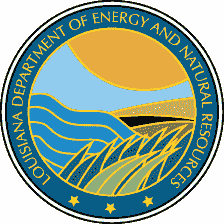Top Stories
DENR to Become C&E on October 1
Contact: Patrick Courreges, 225-342-0510
Re-organization into Department of Conservation and Energy to be finalized at start of month

Along with its organizational restructuring, the agency has also undergone a rebranding that features a new logo, reflecting its updated mission and identity.
BATON ROUGE — Beginning Oct. 1, the Department of Energy and Natural Resources (DENR) will formally complete its re-organization into the Department of Conservation and Energy (C&E).
The re-organization is the result of nearly two years of work, involving legislative actions, input from public stakeholders and intra-agency research and planning, spurred by Gov. Jeff Landry’s executive order, JML 24-13, to then-DENR Secretary Tyler Gray and the Departmental Review for Innovation and Visionary Enhancement (DRIVE) Initiative Gray carried out as a result of that order.
Gray stepped down as secretary earlier this month, with Deputy Secretary Dustin Davidson becoming Secretary, after having worked closely with Gray on planning and implementing the re-organization.
“Throughout this effort, we have worked to craft an approach that is guided by the core principles of transparency in communication and processes, balance in addressing the needs of economic growth and environmental stewardship, and solutions based in technology, with clear guidance to industry and the public,” Davidson said. “In many ways, this agency has still been doing things the way it did when first created as DNR nearly 50 years ago. Technology, industry and environmental best practices have changed a great deal over those decades, and it’s time this agency caught up.”
DENR has previously been made up of four primary divisions – Office of the Secretary, including back office financial functions and the state Energy Office; Office of Conservation, primarily dealing with oil/gas/injection/water wells and pipelines, with regulatory authority separate from the rest of DENR; Office of Coastal Management, dealing with protection of vegetated wetlands in the state’s Coastal Zone; and the Office of Mineral Resources, acting for the state as mineral rights owner in matters of leasing mineral production.
As C&E, the agency will be organized into six divisions, better tailored to specific roles and operations than the previous broad subject matter separations that often led to information silos and inefficient duplication of efforts.
Those offices will be:
- Office of the Secretary – overall strategic management of agency, legal services, staffing the Natural Resources Commission and specialized functions such as Oilfield Site Restoration and LOSCO oil spill response
- Office of Administration – Overseen by the undersecretary, functions as the centralized nexus for all core administrative and strategic operations of the agency, including strategic planning, human resources and fiscal/budget functions
- Office of Permitting and Compliance – Permitting responsibilities formerly split between the Office of Coastal Management and the Office of Conservation, which created potential overlaps and inefficiencies, have been integrated into a centralized structure, creating a unified framework for permitting processes across both coastal and non-coastal areas
- Office of Enforcement – Site inspections, documentation, enforcement of state rules and rules for federal programs over which the state has primacy (i.e. Underground Injection Control)
- Office of State Resources – Oversight of leasing, servitudes and right-of-way for state lands and water resources, staffs the state Mineral and Energy Board
- Office of Energy – Endeavors to catalyze Louisiana’s development of a reliable and resilient energy ecosystem, fostering economic advancement while fortifying energy infrastructure against emerging challenges – tracks energy related statistics and trends, acts as conduit for energy/resilience federal grant funding
“There will still be an adjustment period for some time to come – for our staff, as we break decades worth of old habits and workflows that were inefficient but familiar; for the regulated community, who we hope to see embracing the changes we are making to create understandable and predictable processes; and to the people we serve, as we make the changes needed to set and maintain modern standards for environmental protection and resource management,” Davidson said.
###
News Archives »